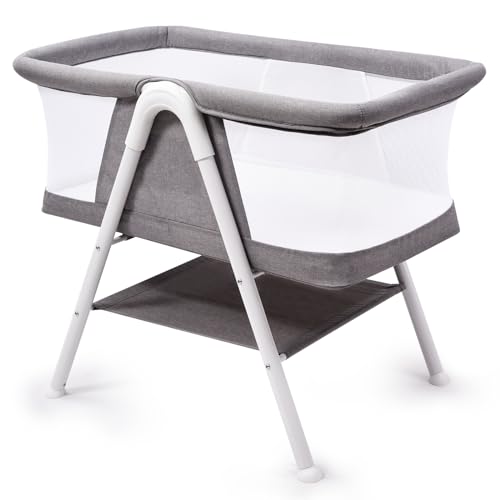10 Sites To Help You Develop Your Knowledge About Bedside Bassinet
The Ultimate Guide to Choosing a Bedside Bassinet: Safety, Comfort, and Convenience
Intro
As new parents enter the exhilarating yet challenging world of child care, one essential product that frequently tops the list is a bedside bassinet. These spaces serve as a safe sleeping location for newborns while allowing parents to preserve close distance throughout the night. With a myriad of alternatives readily available on the marketplace today, comprehending the functions, advantages, and factors to consider for a bedside bassinet can make a significant distinction in the general parenting experience.
This short article will explore the different types of bedside bassinets, security standards, essential features to think about, and some often asked questions to assist you make a notified decision.
What is a Bedside Bassinet?
A bedside bassinet is a sleeping space designed for newborns and infants, generally used for the first few months of a baby's life. It is typically smaller sized than a crib and offers the convenience of being placed beside an adult bed, enabling parents to tend to their babies easily during nighttime.
Types of Bedside Bassinets
There are several types of bedside bassinets available, each developed with distinct features and benefits:
Co-Sleeping Bassinets: These are designed to connect safely to the side of the moms and dad's bed, enabling easy access throughout nighttime feedings and comforting without fully co-sleeping.
Standalone Bassinets: These are free-standing versions that sit next to your bed but do not attach. While they use up more space, they can in some cases offer a bigger sleeping location.
Travel Bassinets: Lightweight and portable, these bassinets are created for families on the go. They can be folded or dismantled easily, offering convenience while taking a trip.
Convertible Bassinets: Some designs can transform into cribs or playards, extending their lifespan and making them a more affordable option.
Benefits of Using a Bedside Bassinet
Choosing a bedside bassinet can give many benefits, consisting of:
Convenience: Parents can easily access their baby during the night for feeding, reassuring, or diaper changes without getting out of bed.
Security: Bassinets are designed particularly for infants, frequently adhering to security standards that help in reducing the threat of Sudden Infant Death Syndrome (SIDS).
Convenience: Babies can feel protected with their parents close by, promoting a sense of security that contributes to much better sleep.
Space-saving: Bedside bassinets are normally compact and easy to suit smaller sized bed rooms.
Secret Safety Features to Consider
When picking a bedside bassinet, guaranteeing safety is paramount. Here are a couple of important security functions to think about:
Stable Base: Ensure the bassinet has a tough structure that can not tip over quickly. Bedside Cot Bed For Newborns that wheels lock into place to prevent motion.
Breathable Fabrics: Look for materials that permit air blood circulation to lower the risk of suffocation.
Height Adjustability: A bassinette that adapts to the height of your bed can enhance security and benefit.
No Drop Sides: Select models that do not have drop sides, as they can position a danger of the baby falling out or getting caught.
Accreditation: Always ensure that the bassinet complies with security requirements set by acknowledged firms like the American Academy of Pediatrics (AAP).
Extra Features to Look For
Aside from security, here are some additional features to think about when searching for the ideal bedside bassinet:
Storage Space: Some bassinets include integrated storage for essentials like diapers, wipes, and outfits.
Rocking or Gliding Mechanism: This can assist relieve babies who have difficulty settling down to sleep.
Noise and Light Features: Some designs consist of soothing sounds, nightlights, or projections that can assist relieve infants to sleep.
Washable Components: Make sure detachable covers and sheets are maker washable for easy cleansing.
Picking the best bedside bassinet is a crucial decision that can profoundly affect the early parenting experience. By understanding the different types offered, their benefits, necessary security functions, and additional benefits, parents can make an informed option to guarantee both their baby's convenience and security.
Ultimately, the right bedside bassinet should deal with private household needs while improving the bond between parents and their newborns throughout those precious first few months.
FAQs about Bedside Bassinets
1. The length of time can I use a bedside bassinet for my baby?
The majority of bassinets are developed for infants up to about 4 to 6 months, or up until the baby can roll over, bring up, or surpass the weight limitation specified by the maker (usually around 20-30 pounds).
2. Are bedside bassinets safe for co-sleeping?
While bedside bassinets use close proximity, it's crucial to ensure they're securely attached to the bed. Constantly follow standards for safe sleeping to decrease the risk of SIDS.
3. Can I use a bedside bassinet for an early baby?
Yes, lots of bedside bassinets can accommodate early infants. Nevertheless, it's necessary to talk to a pediatrician for recommendations based on your baby's specific needs.
4. What should I try to find in regards to mattress safety in a bedside bassinet?
Make sure that the mattress fits securely against the sides of the bassinet with no gaps. The bed mattress needs to be firm and covered with a fitted sheet to lower the danger of suffocation.
5. Are there Baby Co Sleeper Crib cleansing guidelines I should follow?
Most bassinets have removable covers that can be cleaned. Always follow the producer's instructions for cleaning and keeping the bassinet.
By addressing these concerns, parents can navigate the decision-making process relating to bedside bassinets more efficiently, ensuring safety and comfort as they invite their youngster into the world.
